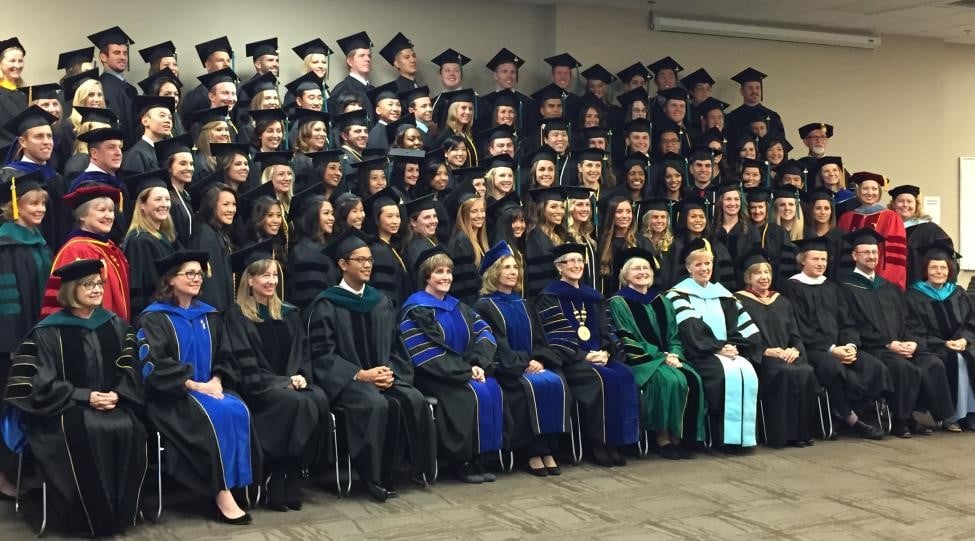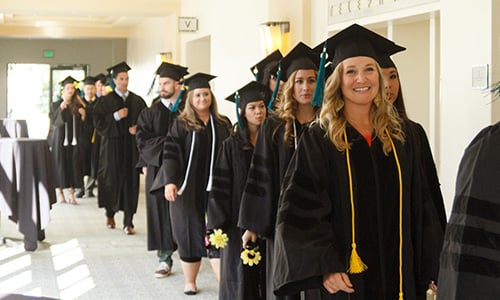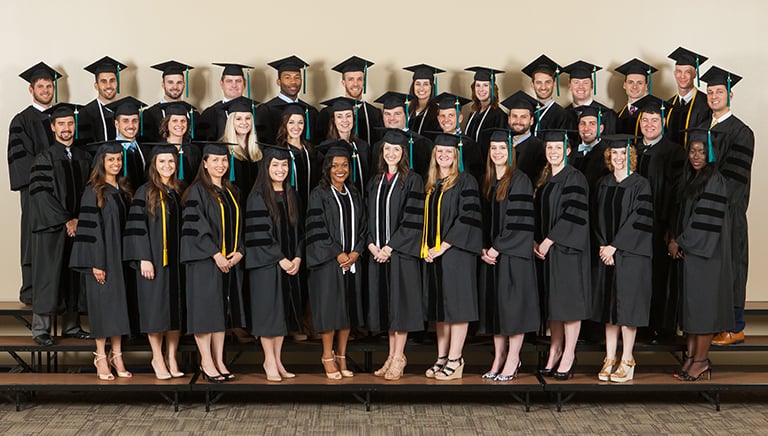
As the U.S. population continues to age, demand for healthcare workers like occupational therapists will grow, too (Vespa, 2019). From 2020-2030, about 10,100 job openings for occupational therapists are projected each year on average with projected change in employment being 23,000. That being said, there’s never been a better time to enter the field of occupational therapy (BLS, 2021). But how much will a degree cost you?
Painting the cost of occupational therapy school with a broad brush is challenging, as there is a range of costs associated with health science schooling. Depending on the state and the occupational therapy program specifics, tuition and associated costs vary.
The salary of your future occupational therapy job is important to factor in as well. A doctor of occupational therapy salary can vary, and occupational therapy vs physical therapy salary is also quite different. For anyone looking to pursue a career in occupational therapy, it’s important to consider earning potential to balance the costs of education.
With that said, occupational therapy school can cost between $65,000 and $200,000 for undergraduate programs and between $20,456 and $35,171 for Post-Professional Occupational Therapy Doctorate programs (PPOTD).


Tuition for Occupational Therapy Education at the University of St. Augustine for Health Sciences
Where we can speak more confidently on tuition expenses is the cost of programs at the University of St. Augustine for Health Sciences (USAHS).
So, how much is occupational therapy school at USAHS? Expenses depend on which campus you attend and fluctuate further depending on whether you follow the Residential path or the more adaptable Flex path to become an occupational therapist. We’ll look at the costs of all possible options.
Master of Occupational Therapy (MOT)
For those passionate about healing their community, the Master of Occupational Therapy (MOT) degree is an obvious choice—most occupational therapists enter the workforce with a master’s degree (BLS, 2021). Because occupational therapists are responsible for developing treatment plans, making equipment recommendations, and more (BLS, 2021), you may think that a degree will take you close to a decade.
However, an occupational therapy student can complete the MOT program in as little as two years. The time it takes depends on whether you take the Residential path (six trimesters; two years) or the Flex path (nine trimesters; three years).
Total program estimates for the MOT program—including tuition, program fees, books, and associated school expenses—are as follows:
- San Marcos, California Campus – $95,297 for Residential MOT students, $84,937 for Flex MOT students.
- St. Augustine, Florida Campus – $87,717 for Residential MOT students, $82.800 for Flex MOT students.
- Miami, FL Campus – $87,717 for Residential MOT students, $82,800 for Flex MOT students.
- Austin, Texas Campus – $87,717 for Residential MOT students, $82,800 for Flex MOT students.
Doctor of Occupational Therapy (OTD)
If the MOT program doesn’t quite quench your thirst for knowledge, you can further your learning with the successful completion of the two additional trimesters of the Doctor of Occupational Therapy (OTD) program. In class, you’ll explore the arts of leadership, policymaking, and advocacy in the public health sector.
A 117-credit-hour program, OTD can be finished in two years and eight months (eight trimesters).
The estimated tuition and fees for Residential OTD students culminate to $108,072 and are the same at all USAHS campuses
A 3.7-year, 11-trimester Flex OTD option is also available at the Dallas, Texas Campus; the estimated cost of attendance is $108,260.00.
Post-Professional Doctor of Occupational Therapy (PPOTD)
The Post-Professional Doctor of Occupational Therapy (PPOTD) program is somewhat different from the other two. As a post-professional program, the curriculum is designed for current practitioners or ready-to-practice occupational therapists looking to advance their studies in the occupational therapy department.
The program is offered online, so tuition estimates are the same regardless of where you reside. However, the program you pursue (and therefore the tuition amount you’ll pay) depends on the degree you currently hold:
- Bachelor’s Level Students – This 60-credit-hour program takes two to five years to complete. Tuition and fees are estimated at $36,186.
- Master’s Level Students – With a master’s degree, students can complete the program in 1-3.3 years. USAHS MOT graduates can apply six of their credits to the PPOTD program, making it a 29-credit-hour program estimated at $22,743. All other master’s degree holders will need to complete a 35-credit-hour program costing $26,876.


Additional Costs
Answering the question “How much is occupational therapy school?” with tuition amounts only gives you half marks. To determine the true cost of attendance, it’s vital to include expenses beyond books and courses in your calculations.
Other typical costs for university students include:
- Room and board – Rent and food costs depend significantly on where you live, but don’t forget to add them into your budget. Room and board estimates include $68,331.00 for the Austin campus, $77,365.00 for the Miami campus, $54,637.00 for the St. Augustine campus, $82,397.00 for the San Marcos campus, and $72,984.00 for the Dallas campus.
- Transportation – Whether you drive or take the bus, there are costs associated with making your way to campus each day. Estimated transportation costs for all campuses are around $8,488.00.
- Additional personal expenses – From entertainment to unforeseen situations, other fees will crop up. Health insurance also falls into this category. According to our estimates, you should budget around $17,579.00 for these costs.
- Repeating academic courses – Hopefully, you won’t have to repeat a course. But if you do, you’ll have to pay for the credit hours again.
How to Cut Costs
How much is occupational therapy school going to cost altogether? It depends on your lifestyle. There are dozens of ways to keep costs down, including:
- Cooking your own food
- Living with roommates
- Furnishing your living space with secondhand items
- Using the library
- Taking public transit
- Studying diligently (to avoid retaking courses)
Beyond all of these budgeting tips, the best way to cut down on the cost of occupational therapy school is to apply for scholarships or financial aid.
OT Scholarships Opportunities at the University of St. Augustine for Health Sciences
In line with our goal of developing professional healthcare practitioners to meet growing demands for occupational therapy practice, the University of St. Augustine for Health Sciences plans to provide over $450,000 in scholarship opportunities for OT program students starting in Summer 2022. Even if you’ve already started an OT degree program application to a USAHS Fall 2022 cohort, you can apply for scholarships or federal student aid.
commitment to bettering their community.
To apply, you’ll be asked for a video submission.
Regardless of how you fund your occupational therapy journey, you’re sure to learn a wealth of new skills and connect with a diverse, passionate student body. For more information on our programs or any other questions such as “where do occupational therapists work”, feel free to get in touch.
Salary data may not reflect starting pay for recent graduates.
Sources:
- Vespa, J. (2019, October 8). The Graying of America: More Older Adults Than Kids by 2035. United States Census Bureau. Retrieved February 17, 2022, from https://www.census.gov/library/stories/2018/03/graying-america.html
- U.S. Bureau of Labor Statistics. (2021, September 8). Occupational Therapists : Occupational Outlook Handbook. U.S. Bureau of Labor Statistics. Retrieved February 17, 2022, from https://www.bls.gov/ooh/healthcare/occupational-therapists.htm
- U.S. Bureau of Labor Statistics. (2021, September 8). Occupational Therapists : Occupational Outlook Handbook. U.S. Bureau of Labor Statistics. Retrieved February 17, 2022, from https://www.bls.gov/ooh/healthcare/occupational-therapists.htm
- U.S. Bureau of Labor Statistics. (2021, September 8). Occupational Therapists : Occupational Outlook Handbook. U.S. Bureau of Labor Statistics. Retrieved February 17, 2022, from https://www.bls.gov/ooh/healthcare/occupational-therapists.htm








